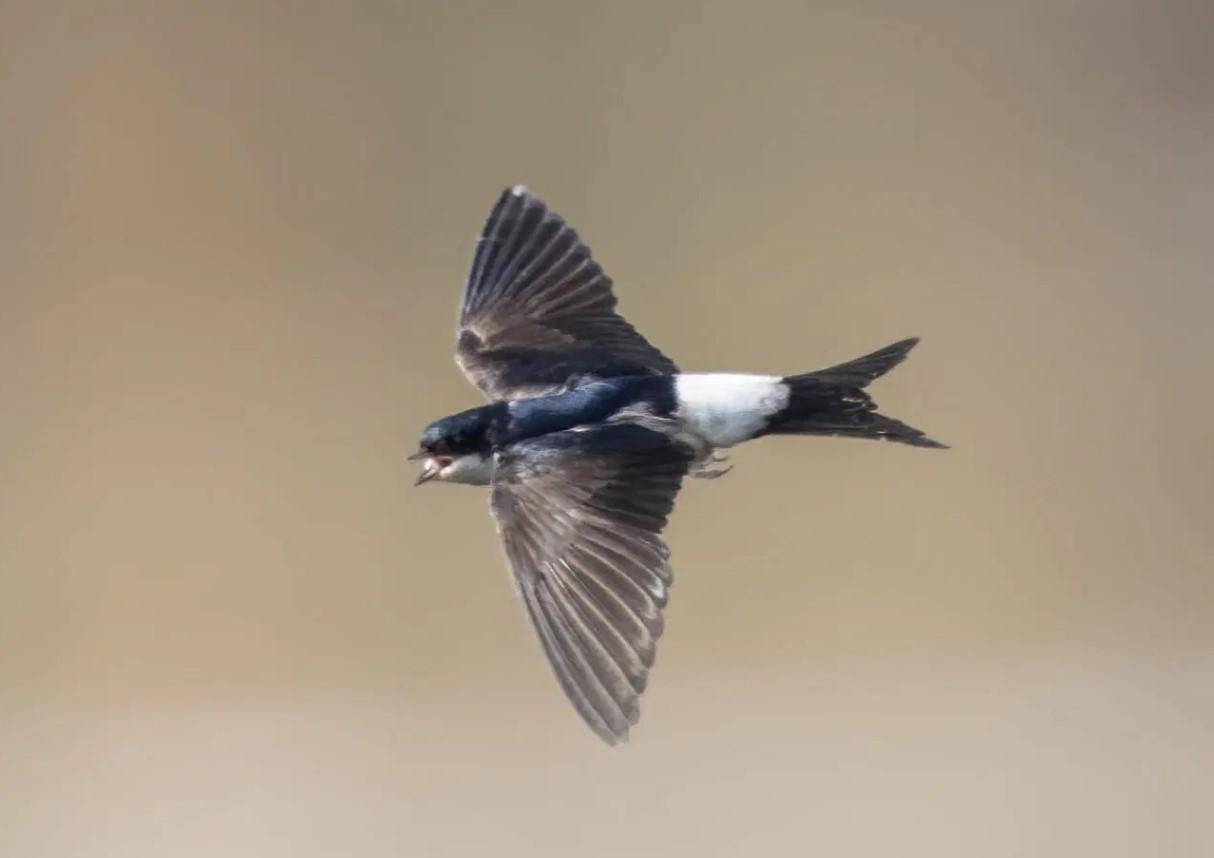Difference Between the Swift, Swallow and House Martin


The difference between the swift, swallow and house martin is not only due to taxonomy. We can identify the differences between swifts, swallows and martins by their plumage and behavior. The tails, wings and coloration of these birds are similar enough that they can become confused with each other. It is also by looking at the differences in these characteristics that we can differentiate between them. We can also look at how they fly, rest and hunt to tell these birds apart.
At thedailyECO, we discover the difference between a swift vs. swallow vs. martin. We do so by looking at the each type of bird individually and then making a comparison between them. We also use photos to help explains these differences more clearly.
Swift characteristics and behavior
Swifts are birds which can be found in the family Apodidae, with two subfamilies known as Cypseloidinae and Apodinae. The type of swift which is most often confused with the houe martin and swallow is the common swift (Apus apus). The name of their genus translates to ‘without feet’ from its original Greek due to this bird's highly aerial behavior.
The feet of the common swift are very short, meaning they can only perch vertically. Although short, they have very strong claws which allow them to adhere to vertical surfaces, although they often will not even come to a complete stop.
The wings of the common swift are long and crescent shaped, giving them a boomerang shape in the air. This helps in aerodynamics because it allows them to maintain sustained gliding when flying. As shown in the photo below, their tails are forked into a V-shape which is relatively short. They have a distinct shrieking call which is higher in females than with male individuals.
Swifts capture their food and nesting materials in the air. The reason they never settle on the ground is due to a fear of predation. Only juveniles are likely to roost in trees or buildings, but some individuals can remain in flight for as long as 10 months at a time[1].
Another of the birds in the family Apodidae is the hummingbird. Learn more about this species with our guide to the best flowers to attract hummingbirds.

Swallow characteristics and behavior
The Ancient Romans believed that swifts were swallows which did not have legs. However, swallows are not related to swifts and come from the family Hirundinidae. This family also contains martins and saw-wings. The birds considered swallows can be found in various genera, including Atticora, Orochelidon, Stelgidopteryx and Tachycineta.
The species which is most commonly confused with the swift is from the genus Hirundo and is known as the barn swallow (Hirundo rustica). This is the most widely distributed type of swallow and is the only one of its genus to be found in the Americas. It is simply known as the swallow in Europe, but they are very migratory.
They have a distinct coloration which is very different from the swift. This is thanks to a metallic blue plumage with a rusty throat. They have white feathers on their front. The barn swallow has the characteristics swallow tail which is deeply forked. They have a staccato birdsong which is sometimes described as a rattle.
Swallows are also noted for their relative friendliness with humans. They use human structures such as houses and buildings to make their nests. They feed mainly on insects.

House martins characteristics and behavior
As stated above, the house martin is also part of the family Hirundinidae, the same family as swallows. While there are different genera of birds in this family known as martins, the house martin belongs to the genus Delichon. The most indicative species is the common house martin (Delichon urbicum).
Also known as the northern house martin, this species has bluish-black plumage. The abdomen ranges from white to grayish. The house martin has a relatively large head and short legs. The feet of the house martin are covered in feathers. This is very uncommon in birds. As shown in the photo, the body is robust and compact.
The wings are straight on the inside. House martins are incredibly skilled skilled fliers that can hunt in the air. It is common to find them hunting in flocks along with swallows. They share feeding habits and a wide distribution throughout Europe, Asia and Africa. This is another of the reasons why it can be difficult to tell the difference between a swift, swallow and house martin.
Similar to the swallow, house martins use houses to build their nests. They usually do so in the eaves. Depending on space, many house martins can build nests together in a colony.

Differences between swift vs. swallow vs. house martin
As you can see from the descriptions and photos of these birds, it is understandable why many people confuse swifts, swallows and house martins. Not only are they physically alike, the house martin and the swallow are part of the same bird family. In fact, some taxonomists believe that house martins and swallows should be part of the same genus.
They have similar evolutionary adaptations, such as their ability to hunt while in the air. We can see a stark difference in certain characteristics and behaviors. These include the short feet of the swift and the fact they remain in the air for the majority of their lives. The other characteristics we can use to identify swifts, swallows and house martins are the following:
- Habitat: all three species inhabit Eurasia and Africa, but the swallow can also be found in the Americas and Australasia. Swifts and house martins are not common to North America. They do visit as vagrant birds, but it is statistically much more common to see a swallow.
- Fork of the tail: the swallow has a very long tail with a broad fork. The swift has a slightly long and forked tail and the martin has a short and slightly forked tail.
- Wings: swifts have crescent-shaped inner wings and are very long, compared to the straight wings of the house martin and swallow. The wings of the latter are not as long in relation to the body.
- Color: swifts are dark brown, while the house martin and the swallow are blue and white. The swallow can be distinguished by their rust colored throats and foreheads.
- Taxonomic rank: swallows are in the genus Hirundo and house martins Delichon, but both belong to the order Passeriformes. Apus is the genus of swifts which are considered Apodiformes.
- Form of flight: the swift is the fastest, followed by the swallow and the house martin is the slowest. The swift hardly stops flying, only usually doing so to perch on walls, rocks or vertical surfaces. The swallow and the house martin stop horizontally especially on wires or ledges.
- Shape of the nest: the swift's nest is built in crevices. The swallow's nest is bowl-shaped and made out of mud. The house martin's nest is also made of mud, but it is globular in shape with a very narrow entrance. They are usually built hanging from ceilings and at great heights.
- Singing: the most melodic are the swallows, the house martin emits one or two metallic notes, and the swift makes almost no noise. The noise it emits is a high-pitched screeching and does not classify as birdsong.
This is the way you can identify the differences between swifts, swallows and house martins. Although they are much large in size, you can learn about the differences between other birds with our guide to the different types of eagle.
If you want to read similar articles to Difference Between the Swift, Swallow and House Martin, we recommend you visit our Facts about animals category.
1. Hedenström, A., Norevik, G., Warfvinge, K., Andersson, A., Bäckman, J., & Åkesson, S. (2016). Annual 10-Month Aerial Life Phase in the Common Swift Apus apus. Current biology: CB, 26(22), 3066–3070. https://doi.org/10.1016/j.cub.2016.09.014
- Pedrocchi-Renault, C. (1987). Ornithic fauna of Alto Occidental Aragón . Spain: Higher Council for Scientific Research.
- Beatty, R., Beer, A., & Deeming, C. (2010). The book of nature. Great Britain: Dorling Kindersley.
- Zoo: magazine of the Barcelona Zoological Park . (1971). Spain: Municipal Service of Parks and Gardens.








